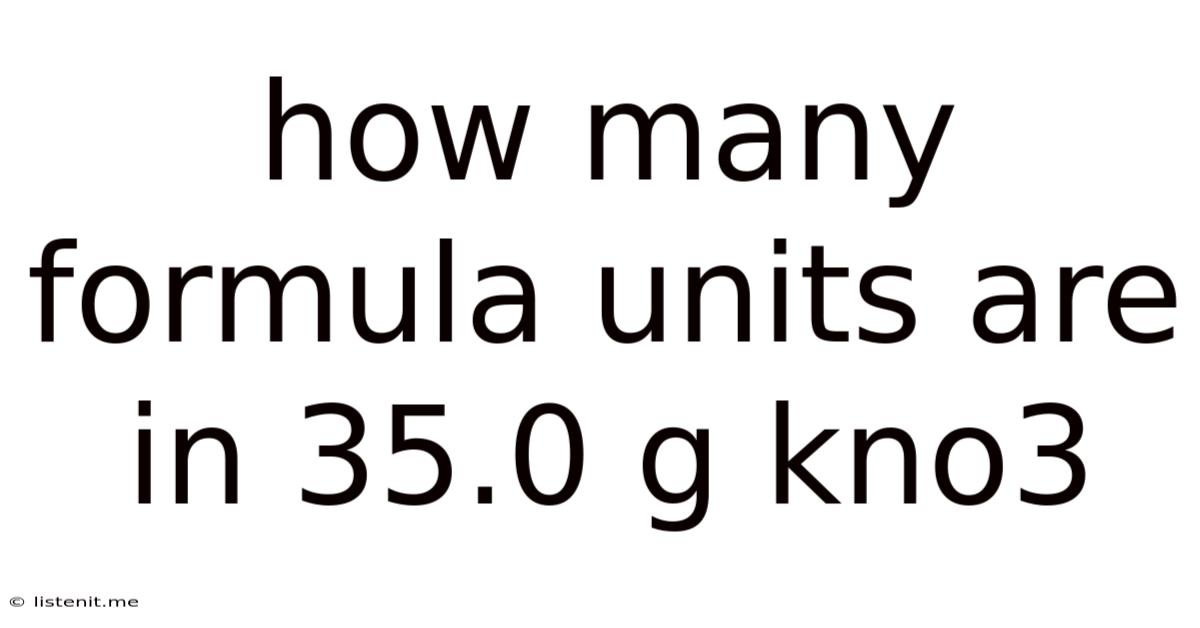How Many Formula Units Are In 35.0 G Kno3
listenit
May 10, 2025 · 4 min read

Table of Contents
How Many Formula Units Are in 35.0 g KNO₃? A Comprehensive Guide
Determining the number of formula units in a given mass of a compound like potassium nitrate (KNO₃) involves a fundamental understanding of molar mass, Avogadro's number, and stoichiometry. This comprehensive guide will walk you through the step-by-step process, providing a clear and detailed explanation along the way. We'll explore the underlying concepts and calculations, ensuring you grasp the principles involved.
Understanding the Fundamentals
Before diving into the calculation, let's review the key concepts:
1. Molar Mass
The molar mass of a compound is the mass of one mole of that substance. It's expressed in grams per mole (g/mol). To calculate the molar mass of KNO₃, we add the atomic masses of its constituent elements:
- Potassium (K): 39.10 g/mol
- Nitrogen (N): 14.01 g/mol
- Oxygen (O): 16.00 g/mol (and there are three oxygen atoms)
Therefore, the molar mass of KNO₃ = 39.10 + 14.01 + (3 × 16.00) = 101.11 g/mol
2. Avogadro's Number
Avogadro's number (N<sub>A</sub>) is a fundamental constant in chemistry, representing the number of entities (atoms, molecules, ions, or formula units) in one mole of a substance. Its value is approximately 6.022 x 10²³ entities/mol.
3. Formula Units
A formula unit represents the simplest whole-number ratio of ions in an ionic compound. Since KNO₃ is an ionic compound, we'll be calculating the number of formula units. For molecular compounds, we'd calculate the number of molecules.
Calculating the Number of Formula Units
Now, let's proceed with the calculation to determine the number of formula units in 35.0 g of KNO₃:
Step 1: Convert grams to moles
We use the molar mass of KNO₃ (101.11 g/mol) as a conversion factor:
moles of KNO₃ = (mass of KNO₃) / (molar mass of KNO₃)
moles of KNO₃ = (35.0 g) / (101.11 g/mol)
moles of KNO₃ ≈ 0.346 mol
Step 2: Convert moles to formula units
We use Avogadro's number (6.022 x 10²³ formula units/mol) as a conversion factor:
formula units of KNO₃ = (moles of KNO₃) x (Avogadro's number)
formula units of KNO₃ = (0.346 mol) x (6.022 x 10²³ formula units/mol)
formula units of KNO₃ ≈ 2.08 x 10²³ formula units
Therefore, there are approximately 2.08 x 10²³ formula units in 35.0 g of KNO₃.
Expanding on the Concepts: A Deeper Dive
Let's delve deeper into the concepts involved and explore some related calculations.
Significance of Molar Mass
The molar mass is crucial because it provides a bridge between the macroscopic world (grams) and the microscopic world (atoms and molecules). It allows us to relate the mass of a substance to the number of particles it contains. Understanding molar mass is fundamental to all stoichiometric calculations. It's essential to accurately determine the molar mass using the periodic table, paying close attention to the number of atoms of each element present in the compound.
Precision and Significant Figures
In our calculation, we used three significant figures for the given mass (35.0 g). Therefore, our final answer should also have three significant figures. Note that Avogadro's number has more significant figures, but we round our final answer to match the precision of the given data. Maintaining consistent significant figures throughout scientific calculations is crucial for ensuring accuracy and reflecting the uncertainty inherent in measurements.
Applications in Chemistry
The ability to determine the number of formula units (or molecules) from a given mass is essential in various chemical calculations. This includes:
- Stoichiometry: Calculating the amounts of reactants and products in chemical reactions.
- Solution Chemistry: Determining the concentration of solutions in terms of molarity (moles per liter).
- Titrations: Analyzing the concentration of unknown solutions.
- Gas Laws: Relating the volume, pressure, and temperature of gases to the number of moles.
Potential Sources of Error
While our calculation is straightforward, potential sources of error exist:
- Impurities in the KNO₃ sample: If the sample isn't pure KNO₃, the actual number of formula units will be different.
- Measurement error: Errors in weighing the sample can affect the final result.
- Rounding errors: Rounding off numbers during the calculation can introduce small errors. However, maintaining consistent significant figures minimizes this effect.
Advanced Calculations: Dealing with Hydrates
Some ionic compounds exist as hydrates, meaning they incorporate water molecules into their crystal structure. For example, copper(II) sulfate pentahydrate is CuSO₄·5H₂O. Calculating the molar mass and the number of formula units for hydrates requires including the mass of the water molecules in the molar mass calculation.
Conclusion
Calculating the number of formula units in a given mass of an ionic compound is a fundamental skill in chemistry. This process involves applying the concept of molar mass, Avogadro's number, and dimensional analysis. Understanding these concepts allows us to bridge the gap between macroscopic measurements and the microscopic world of atoms and molecules, enabling the accurate calculation of the quantities involved in chemical reactions and other chemical phenomena. By mastering these fundamental principles, you will gain a firm foundation for more advanced concepts in chemistry. Remember to always pay attention to significant figures and potential sources of error in your calculations for accurate and reliable results.
Latest Posts
Latest Posts
-
Distance From Earth To Sun In Scientific Notation
May 10, 2025
-
How Many Molecules In 2 0 Moles
May 10, 2025
-
All Buffers Maintain Ph At Around 7 0
May 10, 2025
-
Are Vertical Angles Supplementary Or Congruent
May 10, 2025
-
How To Find Limit As X Approaches 0
May 10, 2025
Related Post
Thank you for visiting our website which covers about How Many Formula Units Are In 35.0 G Kno3 . We hope the information provided has been useful to you. Feel free to contact us if you have any questions or need further assistance. See you next time and don't miss to bookmark.